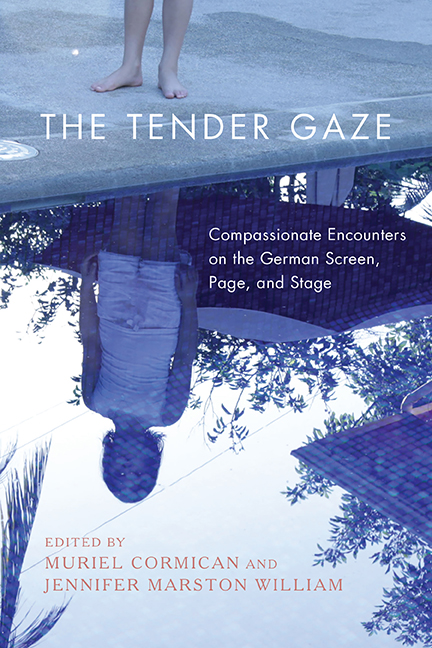Book contents
- Frontmatter
- Contents
- Acknowledgments
- Introduction: The Tender Gaze
- 1 Toward a Theory of the Tender Gaze: Affect, Critical Insight, and Empathy in Contemporary German Cinema
- 2 The Tender Gaze, Embodied Politics, and Perspective-Taking in German Postdramatic Theater
- 3 Face to Face: Race, Gender, and the Gaze in Mo Asumang’s Die Arier
- 4 “Risse, hinter denen man einen Kern entdeckt, der so ähnlich ist wie die Herzen von uns allen”: The Tender Gaze in Umut Dağ’s Risse im Beton
- 5 Looking through the Eyes of Empathy: Encouraging a Culture of Caring and Compassion in Doris Dörrie’s Keiner liebt mich
- 6 The Tender and Transgressive Beast Within: Escape Narratives in Films by Krebitz, Stuber, and Speckenbach
- 7 Looking at Looking in Margarethe von Trotta’s Das Versprechen
- 8 A Queer Phenomenology of Gender in Maren Ade’s Alle Anderen and Toni Erdmann
- 9 Rilke’s “Schauen”
- 10 Pity Stares or Tender Gaze? Seeing Disability in Nineteenth-Century Austrian and German Literature
- 11 The Sociohistorical and Gendered Implications of Gazing Tenderly in Ludwig Tieck’s “Liebeszauber”
- 12 Mothering, Animals, and the Surveillance State in the Anthropocene: An Ecofeminist Reading of Birgit Vanderbeke’s Die Frau mit dem Hund
- Notes on the Contributors
- Index
1 - Toward a Theory of the Tender Gaze: Affect, Critical Insight, and Empathy in Contemporary German Cinema
Published online by Cambridge University Press: 05 October 2022
- Frontmatter
- Contents
- Acknowledgments
- Introduction: The Tender Gaze
- 1 Toward a Theory of the Tender Gaze: Affect, Critical Insight, and Empathy in Contemporary German Cinema
- 2 The Tender Gaze, Embodied Politics, and Perspective-Taking in German Postdramatic Theater
- 3 Face to Face: Race, Gender, and the Gaze in Mo Asumang’s Die Arier
- 4 “Risse, hinter denen man einen Kern entdeckt, der so ähnlich ist wie die Herzen von uns allen”: The Tender Gaze in Umut Dağ’s Risse im Beton
- 5 Looking through the Eyes of Empathy: Encouraging a Culture of Caring and Compassion in Doris Dörrie’s Keiner liebt mich
- 6 The Tender and Transgressive Beast Within: Escape Narratives in Films by Krebitz, Stuber, and Speckenbach
- 7 Looking at Looking in Margarethe von Trotta’s Das Versprechen
- 8 A Queer Phenomenology of Gender in Maren Ade’s Alle Anderen and Toni Erdmann
- 9 Rilke’s “Schauen”
- 10 Pity Stares or Tender Gaze? Seeing Disability in Nineteenth-Century Austrian and German Literature
- 11 The Sociohistorical and Gendered Implications of Gazing Tenderly in Ludwig Tieck’s “Liebeszauber”
- 12 Mothering, Animals, and the Surveillance State in the Anthropocene: An Ecofeminist Reading of Birgit Vanderbeke’s Die Frau mit dem Hund
- Notes on the Contributors
- Index
Summary
THE GAZE, UNDERSTOOD AS a way of looking at others that involves contemplation and the operation of power, has an extensive history and numerous carefully nuanced iterations. I am interested in the power relations of the gaze created and perpetuated by the cinematic apparatus. “Scholars,” Elizabeth R. Baer writes, “have used the concept of the gaze in various contexts often to describe a negative gesture occurring in and defining an oppressive relationship.” All of these scholars recognize the manner in which a narrative perspective assumes a particular viewer, one who is privileged and powerful, and whose perspective is centered. They also all either imply (simply by recognizing a gaze's existence) that such narrative perspectives can be contested. Here, I introduce the concept of the tender gaze: a way of guiding the viewer toward a way of looking that decenters dominant perspectives. The tender gaze does not condescend or reify, it seeks to avoid eroticizing or exoticizing, encourages reorientations and realignments of perspective, and invites the viewer to cast a compassionate rather than a cold eye on others. As Baer elucidates, the gaze in general terms has been cast as a negative exercise of power by the gazer on the person gazed upon. As such, it represents an ideological danger in representations of the other because it constitutes the viewer around a dominant cultural perspective, often dehumanizing that other, the one who deviates and thus must be controlled. The tender gaze, on the other hand, imbues the people and events depicted with a multidimensional complexity, decenters dominant cultural perspectives, and foregrounds anti-racist, anti-sexist, anti-classist, anti-homophobic, and anti-ableist heuristics in encounters with the other.
When Mulvey identifies and analyzes the workings of the male gaze in cinema, she calls attention to something the camera is being made to do that reflects a sexist ideology. When Kaplan identifies and analyzes the imperial gaze, she underscores how it “reflects the assumption that the white, Western subject is central” and calls attention to something the camera is being made to do in the service of maintaining an imperialist ideology.
- Type
- Chapter
- Information
- The Tender GazeCompassionate Encounters on the German Screen, Page, and Stage, pp. 17 - 39Publisher: Boydell & BrewerPrint publication year: 2021

